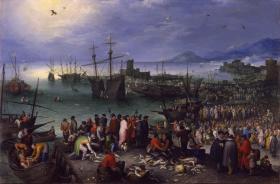
Caesarea, a monumental harbor city founded by Herod the Great late in the first century B.C., is the setting for a teeming crowd of sailors, fishermen, and onlookers, some in turbans and flowing Middle Eastern robes, others in sixteenth-century European garb. The festive air and bustling crowd are true to the account of the Jewish historian Josephus (about 37–95), who described not only the towers of the harbor, but also the numerous people promenading along the seawall. Nearly lost in this mass of humanity is St. Paul. Identified by his halo, he is surrounded by soldiers near the lower right corner. The religious subject seems to be primarily a pretext for painting a marvelous landscape, an initial step toward the development of landscape as an independent subject in the following century.
Executed in oil on copper, this small painting exhibits the jewel-like tones and remarkable attention to minute detail for which Jan Brueghel was famous. His nickname, “Velvet Brueghel,” attests to the nature of his delicate and subtly detailed surfaces. Unlike his older brother Pieter, who concentrated on the rustic imagery introduced into painting by their well-known father Pieter Brueg(h)el the Elder, Jan chose a wide and varied range of subject matter for his pictures, including flower still lifes, landscapes, allegorical and mythological subjects, and religious scenes. After the death of his father when he was only a year old, little is known about Jan, including his training, until he undertook a six-year stay in Italy. He returned to Antwerp in 1596, becoming a prominent member of the painters’ guild and a close friend and collaborator with Peter Paul Rubens.

